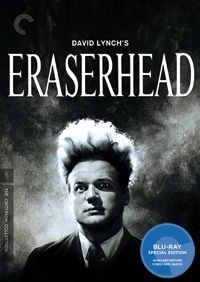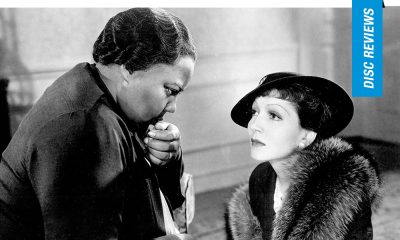Disc Reviews
Criterion Collection: Eraserhead | Blu-ray Review
 There was a time, not very long ago, when obtaining a decent copy of David Lynch’s first masterpiece, Eraserhead, was problematic. Selected in 2004 for preservation in the National Film Registry, nearly four decades of overriding nearly every other piece of flotsam and jetsam comprising the cult classic continuum, one of the most exquisite directorial debuts of all time gets a lavish Criterion Collection treatment. A film whose aural devices equal its bizarre and unforgettable visuals, outside of a theatrical screening, it’s the definitive way to experience this dream of dark and troubling things.
There was a time, not very long ago, when obtaining a decent copy of David Lynch’s first masterpiece, Eraserhead, was problematic. Selected in 2004 for preservation in the National Film Registry, nearly four decades of overriding nearly every other piece of flotsam and jetsam comprising the cult classic continuum, one of the most exquisite directorial debuts of all time gets a lavish Criterion Collection treatment. A film whose aural devices equal its bizarre and unforgettable visuals, outside of a theatrical screening, it’s the definitive way to experience this dream of dark and troubling things.
To outline the narrative of Eraserhead feels rather reductive since the film is a visual and auditory experience that requires first hand exposure. But, basically, it’s about a guy named Henry Spencer (Jack Nance) who is forced to marry a neurotic girlfriend, Mary X (Charlotte Stewart) because she gave birth to a creature/baby he impregnated her with. Outside of this hellish scenario, Henry may be being controlled by The Man Inside the Planet (Jack Fisk) that we see floating around in the opening, and he finds escape in the arms of The Beautiful Girl Across the Hall (Judith Anna Roberts) and a strange singing woman, The Lady in the Radiator (Laurel Near).
A stunning piece of abstract filmmaking, much of Eraserhead’s potency (as well as nearly all of Lynch’s filmography) is due to its ability to confound. There is no definitive interpretation of this industrial nightmare, at least none that Lynch claims has yet been published. But it’s a film that defies categorization as well as clarification, a work of abstract art resistant to exact labels of the conscious mind, which is exactly what gives it the ability to be so effective. It’s been deliberated whether Henry Spencer is being dreamt or is the one perhaps dreaming. The film opens upon a cold, hard rock-like planet with The Man in the Planet moving some levers around, while Henry’s floating head releases a sperm-like creature into the atmosphere, one that resembles what comes to be Henry’s child. Henry is the only character with a first and last name, and most of the other characters are either labels or given questionable identities. They could very well be figments or phantoms even, of Henry’s nightmarish world.
Henry is next seen to be carrying groceries, though any area of commercialism or commerce may as well be in some alternate universe. Eventually, this all turns into what seems a highly stylized metaphor concerning fears of fatherhood (or failing at it), as well as being irreparably trapped by societal expectations due to base human needs. Henry’s impregnation of Mary X with something that may not even be a real child necessitates their marriage and, therefore, a hellish existence where their lives are dictated by this incessantly screaming, gurgling entity. Henry’s burped up sperm has returned to haunt him, but he can hardly help himself, can he? Later, when his own head plops off and jettisons into Man in the Planet realm to be refashioned into eraser heads, the child/creature’s head pushes itself out of his body, so perhaps it is a direct manifestation of his id. It seems there’s no denying the creature is his ‘fault,’ and the lives of others are made to suffer because of his innate, sexual drive and its resulting consequences.
Other females, like the Beautiful Girl Across the Hall and the Lady in the Radiator are other figures of masculine fantasy. Seduced by his neighbor after Mary X flees his cramped apartment, Henry is disappointed when he finds the woman has no intentions of continuing the fling. Likewise, the Radiator gal, with her excessive pancake make-up, desperate to entertain, is the perfect girl next door. Not only is she allergic to the sperm-like creatures flung on her stage, she gleefully and unabashedly stomps on them. Perhaps this is why she is the figure that embraces him during the final white-out, the female immune to being soiled by his functions. When Henry begins to cut the creature’s bandaging, which happens to hold the organs together, it causes the final cataclysm, the child’s heading growing to huge proportions and then becoming the planet from the film’s opening, the Man Inside the Planet furiously pulling his levers which sputter and spark. Perhaps this means that rejecting one’s offspring, which inadvertently become our world, is the only escape from a hellish, Sisyphean conundrum. Or maybe that’s not what it’s saying in the least. To discuss Eraserhead and not use the words ‘perhaps’ or ‘maybe’ seems nearly impossible.
Disc Review
Criterion’s 4K digital restoration is magnificent. If you turn down the lights and turn up the volume, this is a fantastic immersion into Lynch’s urban industrial nightmare. Just as there was a time when obtaining a decent copy of Eraserhead meant embarking on a determined quest, it was even more difficult for Lynch aficionados to get their hands on his preceding short films, and six of them (one is more recent, from 1995) are presented in new 2K digital restorations. A slew of other special features are also included for this lovingly rendered debut of Lynch’s, his first (and hopefully not last) entry into the Criterion Collection.
Short Films:
Each film receives a short introduction from David Lynch.
Six Men Getting Sick (1967):
The short that started it all is a four minute film of a continuous, animated loop born from the idea that Lynch wanted to see one of his paintings in motion.
The Alphabet (1968):
Inspired by his niece’s nightmare, a young girl has a strange, disturbing dream about the alphabet. The short is an even mixture of animation and live action, starring his wife at the time, Peggy.
The Grandmother (1970):
The most involving short in the collection at thirty four minutes, an abused young boy in a family of white powdered people plants a strange seed in the guest bedroom and grows himself a grandmother, someone who will finally be kind to him.
The Amputee, Version 1 and Version 2 (1974):
At a period when Eraserhead was delayed, Lynch and cinematographer Elmes filmed two versions of this short, which came about because AFI was testing some film stock, which explains the two versions. Lynch used the opportunity to make a short story about a double amputee (Coulson) writing a letter, heard omnisciently while her bandages are changed.
Premonitions Following an Evil Deed (1995):
A fifty-five second film using an original Lumiere Bros. camera flies by quickly, composed of a few vintage shots telling a quick story following a crime.
Supplements:
There are eight supplements, arranged by year, concerning the film.
1977: A variety of film stills from the time of release.
1979: An interview with Lynch and Elmes where they revisit a filming location, which now happens to be the Beverly Center. Lynch discusses the corpse of a feline still on site, which had been preserved due to the pool of tar it had been dipped into.
1982: The famed Woody Woodpecker trailer that accompanied the Nuart Midnight Screenings for a majority of its four year run.
1988: Jack Nance and David Lynch on a drive to revisit a filming location for a French television production, Cinema de Notre Temps. While this visit is of interest, the interaction between Nance and Lynch is of real interest.
1997: Lynch and several crewmembers revisit the American Film Institute locations, where they were holed up for nearly the entire five year production. Lynch discusses how he had a meeting at Universal about the film, which last six or seven minutes.
2001: An 85 minute documentary from Lynch made in 2001 discusses the making of the film, which goes in depth about the origins and eventual muted reception (and his attempts to enter the film into the Cannes Film Festival).
2014: Criterion includes brand spanking new interviews with surviving crew members Catherine Coulson, Charlotte Stewart, Fred Elmes, and Judith Anna Roberts, none of who have lost their extreme excitement and vibrant recollection of their memorable experiences making the film.
Final Thoughts
An unparalleled film of strange beauty, Eraserhead might be one of the most perfect demonstrations of the power of film as a medium and an artistic achievement. This dream of dark and troubling things is arguably the most beautiful nightmare you’re apt to see.
Film: ★★★★★/☆☆☆☆☆
Disc: ★★★★★/☆☆☆☆☆
Los Angeles based Nicholas Bell is IONCINEMA.com's Chief Film Critic and covers film festivals such as Sundance, Berlin, Cannes and TIFF. He is part of the critic groups on Rotten Tomatoes, The Los Angeles Film Critics Association (LAFCA), the Online Film Critics Society (OFCS) and GALECA. His top 3 for 2021: France (Bruno Dumont), Passing (Rebecca Hall) and Nightmare Alley (Guillermo Del Toro). He was a jury member at the 2019 Cleveland International Film Festival.

































